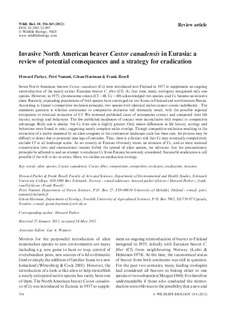| dc.contributor.author | Parker, Howard | |
| dc.contributor.author | Nummi, Petri | |
| dc.contributor.author | Hartman, Göran | |
| dc.contributor.author | Rosell, Frank | |
| dc.coverage.spatial | Finland | |
| dc.date.accessioned | 2016-11-05T22:17:33Z | |
| dc.date.accessioned | 2017-04-19T12:24:34Z | |
| dc.date.available | 2016-11-05T22:17:33Z | |
| dc.date.available | 2017-04-19T12:24:34Z | |
| dc.date.issued | 2012-12 | |
| dc.identifier.citation | Parker, H., Nummi, P., Hartman, G. & Rosell, F. Invasive North American beaver Castor canadensis in Eurasia: a review of potential consequences and a strategy for eradication. Wildlife Biology 18(4):354-365, 2012 | |
| dc.identifier.issn | 1903-220X | |
| dc.identifier.uri | http://hdl.handle.net/11250/2437956 | |
| dc.description.abstract | Seven North American beavers Castor canadensis (Cc) were introduced into Finland in 1937 to supplement an ongoing reintroduction of the nearly extinct Eurasian beaver C. fiber (Cf). At that time, many zoologists recognised only one species. However, in 1973, chromosome counts (Cf¼48, Cc¼40) acknowledged two species, and Cc became an invasive alien. Recently, expanding populations of both species have converged on two fronts in Finland and northwestern Russia. According to Gause’s competitive exclusion principle, two species with identical niches cannot coexist indefinitely . The imminent question is whether coexistence or competitive exclusion will ultimately result, with the possible regional extirpation or eventual extinction of Cf. We reviewed published cases of interspecies contact and compared their life history, ecology and behaviour. The few published incidences of contact were inconclusive with respect to competitive advantage. Body size is similar, but Cc litter size is slightly greater. Only minor differences in life history, ecology and behaviour were found to exist, suggesting nearly complete niche overlap. Though competitive exclusion resulting in the extinction of a native mammal by an alien congener at the continental landscape scale has been rare, the process may be difficult to detect due to potential time lags of centuries. Thus, there is a distinct risk that Cc may eventually competitively exclude Cf at all landscape scales. As no country in Eurasia obviously wants an invasion of Cc, and as most national conservation laws and international treaties forbid the spread of alien species, we advocate that the precautionary principle be adhered to and an attempt to eradicate Cc from Eurasia be seriously considered. Successful eradication is still possible if the will to do so exists. Here, we outline an eradication strategy. | |
| dc.language.iso | eng | |
| dc.publisher | Oikos | |
| dc.rights.uri | https://creativecommons.org/licenses/by/4.0 | |
| dc.subject | alien species | |
| dc.subject | Castor canadensis | |
| dc.subject | Castor fiber | |
| dc.subject | competition | |
| dc.subject | competitive exclusion | |
| dc.subject | eradication | |
| dc.subject | invasion | |
| dc.title | Invasive North American beaver Castor canadensis in Eurasia: a review of potential consequences and a strategy for eradication | |
| dc.type | Journal article | |
| dc.type | Peer reviewed | |
| dc.description.version | Published version | |
| dc.rights.holder | copyright Wildlife Biology, NKV | |
| dc.subject.nsi | 480 | |
| dc.source.journal | Wildlife Biology | |
| dc.identifier.doi | http://dx.doi.org/10.2981/12-007 | |

